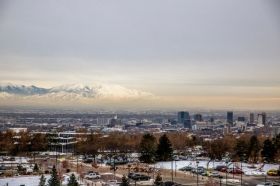In February 2001, before the Olympic cauldron in Salt Lake City roared to life and focused the world’s spotlight on Utah, scientists at the University of Utah placed the first of several carbon dioxide (CO2) sensors atop a building on campus.
CO2 is a key greenhouse gas leading to anthropogenic climate change, with cities around the world as major emitters of CO2. Now five CO2 sensors monitor the air at sites on the Salt Lake Valley floor. It’s the only multisite urban CO2 network in the world with more than a decade of continuous measurements– and it’s showing how urban and suburban growth impacts a metro area’s CO2 emissions.
In a study published today in Proceedings of the National Academy of Sciences, a team led by atmospheric scientists Logan Mitchell and John Lin report that suburban sprawl increases CO2 emissions more than similar population growth in a developed urban core.
“The general thought is that more compact cities on a per capita basis emits less carbon,” Lin says. “Some of these cities also have these expanding fringes. These places are less ‘green’, so to speak. That expanding frontier is moving.”
Continue reading at University of Utah
Image via University of Utah


